
Chinese Open Work Charms

"Hollowed Out" Money
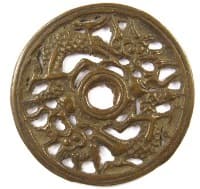 These are charms
that have irregular shaped "openings" or "holes"
between their exquisite design elements. They
are round and almost always have a round hole in the
center. Open work charms with scenes of
buildings such as temples, however, tend to have
square holes in the middle.
These are charms
that have irregular shaped "openings" or "holes"
between their exquisite design elements. They
are round and almost always have a round hole in the
center. Open work charms with scenes of
buildings such as temples, however, tend to have
square holes in the middle.Open work charms are almost purely pictorial and only a very few include any Chinese characters or inscription. The picture on one side is the same as that on the other side, only reversed. Therefore, only one side of each charm is displayed below.
Chinese open work charms made their first appearance during the Han Dynasty (206 BC - 220 AD) although many of the specimens from that time may have actually been small pieces taken from other metal utensils.
Open work charms became very popular and were often worn for personal adornment during the Song (960 -1279 AD), Yuan (1271 - 1368 AD) and Ming (1368 - 1644 AD) dynasties. Their popularity, however, seemed to wane somewhat during the Qing (Ch'ing) Dynasty (1644 - 1911 AD).
Compared to most other types of Chinese charms, open work pieces tend to be larger in size with more made of bronze than brass.
Categories of Open Work Charms
One category includes those animals much beloved to the Chinese with the dragon and phoenix being the most prominent. Also included in this group would be fish, deer, lion, tiger, rabbit, bat, birds, crane, horse and the Chinese unicorn or qilin (麒麟).
A second category depicts immortals, such as the Queen Mother of the West (xi wang mu 西 王母), as well as ordinary people, especially those involved in fishing and hunting. Fu Xi (伏羲), the ancient mythic ruler traditionally credited with establishing the fundamental principles of the Book of Changes (I Ching 易经), gave humanity the skills of animal husbandry and fishing with nets. During the Han Dynasty, when charms first started to appear, fishing and hunting and other daily life scenes were painted on bricks and these popular artistic forms were carried over into the creation of open-work charms. (For additional information concerning Fu Xi and the Book of Changes (I Ching) please refer to The Book of Changes and Bagua charms.)
Also included in this category are some fairly scarce open work charms illustrating examples of Confucian filial piety.
A third category displays climbing vines, peach blossoms, lotus and peony. To the Chinese, these vines and plants carry hidden meanings in addition to their high artistic value. There is an interesting legend, dating from the Tang Dynasty, that I relate below along with images of peony open work charms. If you have further interest in Chinese charms and their symbolism, please also see the hidden meaning of Chinese charm symbols.
A fourth category includes scenes of buildings such as temples. Most of these open work charms are believed to have been cast in Dali (大理) in Yunnan (云南) Province during the Ming Dynasty (1368 - 1644 AD).
Open Work Charms with
Immortals and People
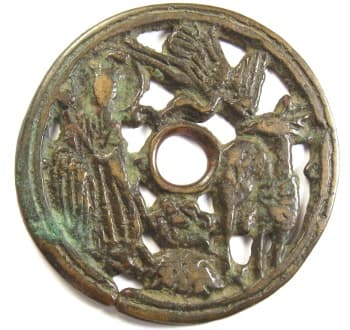
This is an interesting old charm depicting an immortal and several "good luck" animals.
At the left is the Queen Mother of the West (xi wang mu 西王母). She is holding a ruyi (如 意) sceptre which extends from her hand to the 10 o'clock position on the rim.
On the right side of the charm is a deer.
A tortoise is at the very bottom of the charm at the 6 o'clock position.
There is an "auspicious cloud" located just above the tortoise and below the round center hole.
Above the center hole is a crane. The crane's beak is touching the center hole at the 11 o'clock position and the tips of the two wings are at the 12 o'clock and 1 o'clock positions of the outside rim.
The Queen Mother of the West (xiwangmu 西王母) is associated with longevity because eating a peach from her orchard would allow a person to live for 3,000 years.
The deer is believed to live a long life and is, therefore, a symbol of longevity. The Chinese word for "deer" (lu 鹿) is pronounced the same as the Chinese character 禄 (lu) which refers to the salary of a government official. The deer thus also signifies wealth and good fortune.
The tortoise (gui 龟) is another natural symbol for a long life.
The cloud (yun 云), also known as an "auspicious cloud" (xiangyun 祥云), symbolizes "good luck" because it has the same pronunciation as the Chinese word for "luck" or "fortune" (yun 运).
The crane (he 鹤) is yet another ancient Chinese symbol for longevity.
This charm is therefore expressing the desire for a long life with the wealth and good fortune that accompanies being appointed to a high government position. The ruyi (如意) sceptre literally translates as "according to your wishes".
The diameter of this open work charm is 54 mm and the weight is 31.5 grams.
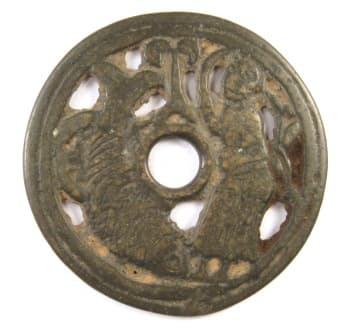
This is an example of an ancient open work charm showing a man fishing. The man is on the right with the fish on the left.
The fish symbolizes prosperity because the Chinese word for fish (yu 鱼) is a pun for "abundance" or "well-to-do" (yu 余 or yu 裕).
The fish also alludes to an allegory of a carp fish leaping over the Dragon Gate to become a dragon (liyutiaolongmen 鲤鱼跳龙门) which illustrates that persistent efforts are needed to overcome obstacles as in the case of those who wish to move up the ranks as officials in the imperial examination system. (Please see fish charms for additional information)
There is still another interpretation of the meaning of this charm. The human figure may actually be a woman. The Chinese word for woman (fu 妇) has the same pronunciation as the word "wealth" (fu 富). Since the word "fish" sounds like "abundance", the hidden meaning of the picture is an abundance of wealth.
Also, in the folk art of the Miao people of Southern China, the fish symbolizes women.
The diameter of this charm is 53 mm.
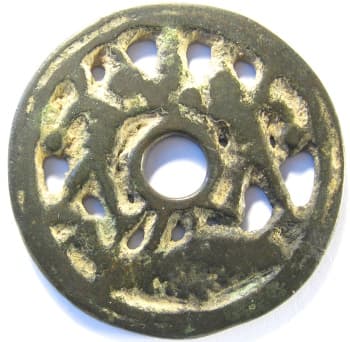 This is a most
unusual and rarely seen charm.
This is a most
unusual and rarely seen charm.The charm shows two people with one to the left and one to the right of the round hole.
At the very bottom of the charm is a fish with its head at the right and tail at the left.
Traditionally, this charm was believed to portray a daily scene of people working with the hope of becoming prosperous.
But if you look closely, the two people actually appear to be warriors fighting with their fists. While it is difficult to see in this image, there is also a small battle shield at the top of the charm between the two heads.
The fish, in this case, symbolizes a river where a battle is taking place.
The scene is now believed by some experts to represent the war known as the Chu-Han Contention (chu han xiang zhen 楚汉相争) which took place during the years 206 BC to 202 BC between the armies of Chu (楚) and Han (汉) following the collapse of the Qin Dynasty.
Xiang Yu (项羽), the Hegemon-King of Western Chu (xi chu ba wang 西楚霸王), and Liu Bang (刘邦), the leader of Han, fought a decisive battle by the Wu River (乌江) in 202 BC.
Xiang Yu was defeated and, rather than returning home in disgrace, committed suicide by cutting his throat near the river.
Liu Bang then proceeded to establish himself as Emperor Gaozu (高祖), the first emperor of the Han Dynasty.
This charm has a diameter of 42 mm and a weight of 17.6 grams.
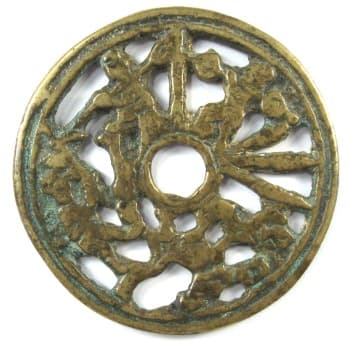
This is an ancient Chinese charm with a Confucian filial piety theme.
Filial piety refers to the respect of a child for his parents.
The charm displays four stories from "The Twenty-Four Examples of Filial Piety" (ershisixiao 二十四孝) which is one of the most famous historical collections of stories concerning how children displayed filial piety.
For an interesting discussion of this charm please see Confucian Charms.
The charm is 59 mm in diameter.
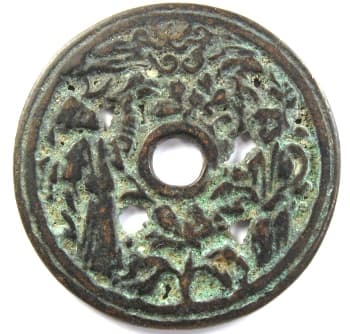 This charm is a pictorial representation of the
ancient Chinese saying hua
qian yue xia (花前月下) which literally translates as "in
front of the flowers and under the moon".
This charm is a pictorial representation of the
ancient Chinese saying hua
qian yue xia (花前月下) which literally translates as "in
front of the flowers and under the moon".The scene illustrates a young couple falling in love in the moonlight among flowers.
On the left is a man standing and pointing with his left hand at the moon.
If you look carefully, you will see a crescent moon exactly at the 12 o'clock position with curly-shaped clouds just below and to the sides.
Standing on the right is a young woman with flowers shown both above and below the circular hole.
This type of charm was cast in ancient times in the city of Dali in Yunnan Province.
To see other charms relating to love, sex, and marriage, please visit Chinese Marriage Charms.
This charm has a diameter of 47 mm and a weight of 21.7 grams.
Dragon Open Work Charms
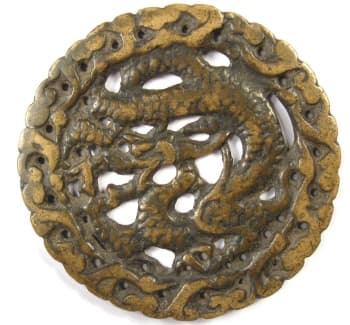
The dragon is often the theme of open work charms with the vast majority of dragon charms depicting two dragons.
Charms with a single dragon are not frequently seen.
This is a very nice example of an old open work charm with one dragon.
The dragon is facing left with its head located just to the left of center.
The dragon's neck assumes an "S" shape extending toward the bottom of the charm where the body then coils upward and over the head.
This is a very large and heavy charm. The diameter is 66 mm and the weight is 64.2 grams.
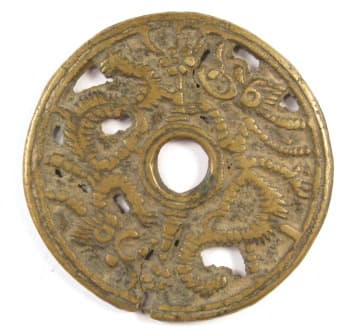
This is an example of a double dragon open-work charm with one dragon each on the right and left. The dragon on the right (head at the one o'clock position) appears to be chasing the tail of the other (head at the seven o'clock position) in a counter-clockwise direction around the central hole.
There is a small flower in the area (twelve and six o'clock positions) between each head and tail.
The charm is 53 mm in diameter and weighs 25.9 grams.
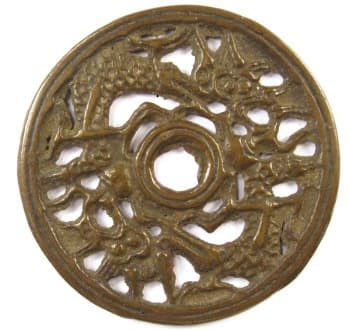
This is another double dragon open work charm.
To make viewing easier, I have rotated the charm so that one of the dragons is on the top and one is on the bottom.
The head of the top dragon is at the one o'clock position. The two round dots are the eyes and the two horns are pointing to the top of the charm. The body extends counter-clockwise and a leg can be clearly seen with the claw resting at the eleven o'clock position on the central hole.
This charm has a diameter of 52 mm and a weight of 20.1 grams.
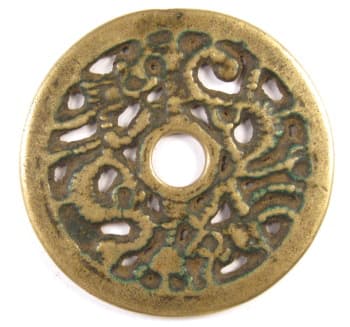
This old open-work charm shows considerable wear but also displays two dragons, one on the right and one on the left. The dragon on the left (head at the eleven o'clock position) is chasing the tail of the dragon on the right (head at five o'clock position) in a clockwise direction.
The diameter is 55 mm and the weight is 30.2 grams.
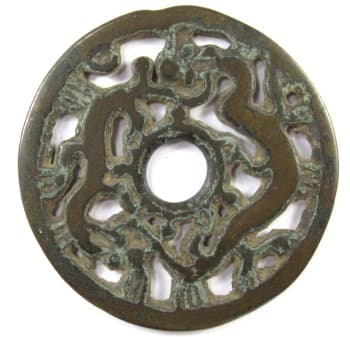
This is a very old two dragon open work charm which probably even predates the above charm.
The diameter is 54 mm and the weight is 28.3 grams.
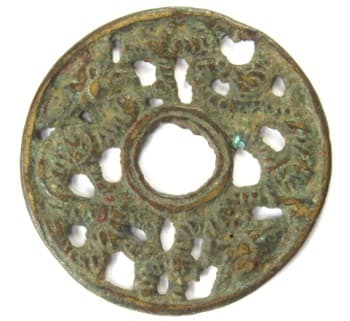
This is another example of an old two dragon charm with a beautiful patina. The head of the dragon on the left side is at the eleven o'clock position. Its right eye is the brown dot and its mouth is open. The head of the dragon on the right side is at the five o'clock position.
One dragon is chasing the other in a clockwise rotation.
This is a smaller charm with a diameter of 41 mm and a weight of 10.2 grams.
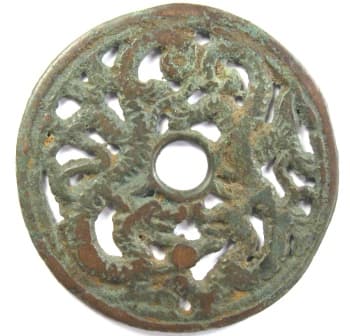
This open work charm is different and much less common than the above dragon charms.
In this case, the two heads of the dragons are facing each other nose-to-nose just below the circular hole with the two tails meeting at the very top of the charm.
Just below the two heads is a round dot representing a pearl.
For reasons which are still unknown, very few double dragon charms were cast with the dragons facing each other. The vast majority of charms of this type have one dragon chasing the tail of the other.
This charm has a diameter of 54.2 mm and a weight of 25.9 grams.
Lion Open Work Charm
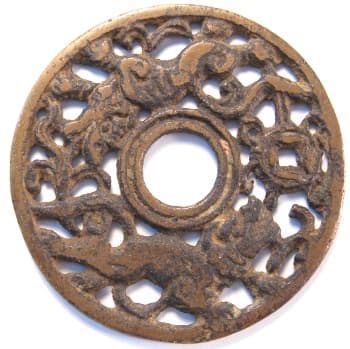
The lion is seen as a
brave and intelligent animal and, therefore, has come to
symbolize power and majesty.
The open work charm at the left displays a pair of lions playing with a "treasure" (shuang shi xi bao 双狮戏宝).
The "treasure", located at the right of the center hole, is a traditional Chinese cash coin which is round with a square hole in the middle.
One lion is just below and looking directly at the "coin". The other lion is upside-down with its head at the ten o'clock position.
However, the lion has an even deeper symbolic meaning because the Chinese word for lion (shi 狮) has the same pronunciation as the word for "teacher" or "master" (shi 师).
Beginning as early as the the Western Zhou Dynasty (11th century BC - 771 BC), the highest civil official was the "Senior Grand Tutor" (tai shi 太师), also known as the "Grand Preceptor" or "Grand Secretary". And beginning in the Spring and Autumn Period (770 BC - 476 BC), the state of Chu (楚国) had a senior government office known as the "Junior Preceptor" (shao shi 少 师).
A pair of lions (shi 狮) thus symbolizes these two high government positions (shi 师) and the "treasure" coin (bao 宝) represents their remuneration or salary.
This Chinese charm thus expresses the wish that position and wealth will be handed down from generation to generation.
This lion charm has a diameter of 44 mm and a weight of 13.4 grams.
The open work charm at the left displays a pair of lions playing with a "treasure" (shuang shi xi bao 双狮戏宝).
The "treasure", located at the right of the center hole, is a traditional Chinese cash coin which is round with a square hole in the middle.
One lion is just below and looking directly at the "coin". The other lion is upside-down with its head at the ten o'clock position.
However, the lion has an even deeper symbolic meaning because the Chinese word for lion (shi 狮) has the same pronunciation as the word for "teacher" or "master" (shi 师).
Beginning as early as the the Western Zhou Dynasty (11th century BC - 771 BC), the highest civil official was the "Senior Grand Tutor" (tai shi 太师), also known as the "Grand Preceptor" or "Grand Secretary". And beginning in the Spring and Autumn Period (770 BC - 476 BC), the state of Chu (楚国) had a senior government office known as the "Junior Preceptor" (shao shi 少 师).
A pair of lions (shi 狮) thus symbolizes these two high government positions (shi 师) and the "treasure" coin (bao 宝) represents their remuneration or salary.
This Chinese charm thus expresses the wish that position and wealth will be handed down from generation to generation.
This lion charm has a diameter of 44 mm and a weight of 13.4 grams.
Phoenix Open Work Charm
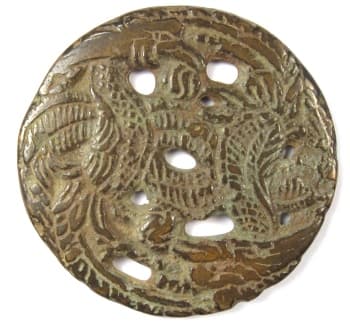
While open work charms displaying dragons are fairly common, there seems to be far fewer displaying the Chinese phoenix.
The mythical bird we commonly call the "Chinese phoenix" is actually the fenghuang (凤凰) in Chinese. The fenghuang does not symbolize a bird that rose from ashes as is the case with the "phoenix" known in the West. The Chinese phoenix instead represents joy and peace. The phoenix is the yin counterpart to the dragon. A dragon and phoenix paired together represent the happy and harmonious union of a man and woman. For more information on the symbolism please see the Hidden Meaning of Chinese Charms.
This very attractive double phoenix bronze charm has one phoenix on the left and another, which is upside down, on the right.
Regarding the phoenix on the left, the head is at the top of the charm with the beak just touching the hole at the upper right.
The body is shaped like an "s" and the neck and breast appear to have tiny scales. One feathered wing extends to the nine o'clock position while the other wing extends above the upper part of the hole in the middle of the charm.
Four long tail feathers can be seen. The Chinese believe that even numbers are yin (female) and odd numbers are yang (male).
The phoenix on the right is depicted exactly the same but is upside down with the beak just below the hole at the lower right and with the head at the five o'clock position.
This is a robust charm. It is almost 58 mm in diameter, about 3.5 mm in thickness, and quite heavy.
Peacock Open Work Charm
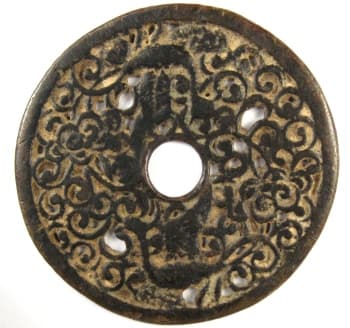
There is a difference
of opinion regarding which bird is depicted on this
charm. Some references say that it is the Chinese phoenix.
Other texts state that it is the peacock.
Those arguing that it is the phoenix, however, fail to explain why most of the field of the charm is covered with interlocking eye-like swirls such as found on the spectacular tail of the peacock.
Since most phoenix charms depict the tail as long flowing tail feathers, as in the example above, I believe the stronger case is for the peacock.
There are actually a pair of peacocks depicted on the charm.
As seen in the view to the left, there is one peacock, upside-down and facing to the right, at the top of the charm. The other peacock is at the bottom and facing left.
Those arguing that it is the phoenix, however, fail to explain why most of the field of the charm is covered with interlocking eye-like swirls such as found on the spectacular tail of the peacock.
Since most phoenix charms depict the tail as long flowing tail feathers, as in the example above, I believe the stronger case is for the peacock.
There are actually a pair of peacocks depicted on the charm.
As seen in the view to the left, there is one peacock, upside-down and facing to the right, at the top of the charm. The other peacock is at the bottom and facing left.
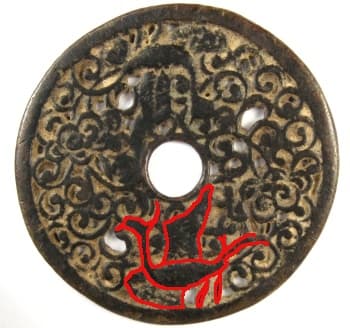
Because of the wear on
the charm, I have outlined the body of one peacock in
red to make it more obvious. The head is facing
left with one wing pointed straight up and the other
wing extended toward the bottom of the charm.
The two legs can be seen just below the peacock's body.
With wings extended, it is as if the pair of peacocks are preparing to fly.
The enormous tail of the bottom peacock, highlighted by the many swirls, covers the entire right field of the charm to about the one o'clock position where the head of the other peacock is located. The tail of the top peacock envelopes the left field of the charm.
It is interesting that the design of the charm intimately connects the pair of peacocks by means of the tail feathers which resemble the Chinese mudan (牡 丹) flower, also known as the tree peony, and vines.
To the Chinese, the peacock represents beauty and dignity, and the desire for peace and prosperity.
Similarly, the mudan symbolizes loyalty, happiness and eternal beauty. The tree peony is also known in Chinese as fuguihua (富贵花), meaning "flower of wealth and honor", and therefore expresses the hope for prosperity and official position.
The hidden or implied meaning of this charm is that a pair of peacocks are a devoted couple which fly side by side in the heavens and are like flowers with interlocked branches on earth. The pair symbolize mutual affection between lovers.
In ancient times, there was also the belief that one glance from a peacock could make a woman pregnant.
Xi Wang Mu (西王母), the Queen Mother of the West, sometimes rode a peacock as a means of transportation instead of a stork. (Please see Chinese Peach Charms for more on the Queen Mother of the West.)
These charms are generally believed to have been cast in the southern province of Yunnan during the Song (960-1279 AD) and Jin (1115-1234 AD) dynasties.
The peacock is indigenous to the rain forests of Yunnan Province and has traditionally been an inspirational source for the arts and dance of such ethnic minorities as the Dai people.
This charm has a diameter of 56.5 mm.
The two legs can be seen just below the peacock's body.
With wings extended, it is as if the pair of peacocks are preparing to fly.
The enormous tail of the bottom peacock, highlighted by the many swirls, covers the entire right field of the charm to about the one o'clock position where the head of the other peacock is located. The tail of the top peacock envelopes the left field of the charm.
It is interesting that the design of the charm intimately connects the pair of peacocks by means of the tail feathers which resemble the Chinese mudan (牡 丹) flower, also known as the tree peony, and vines.
To the Chinese, the peacock represents beauty and dignity, and the desire for peace and prosperity.
Similarly, the mudan symbolizes loyalty, happiness and eternal beauty. The tree peony is also known in Chinese as fuguihua (富贵花), meaning "flower of wealth and honor", and therefore expresses the hope for prosperity and official position.
The hidden or implied meaning of this charm is that a pair of peacocks are a devoted couple which fly side by side in the heavens and are like flowers with interlocked branches on earth. The pair symbolize mutual affection between lovers.
In ancient times, there was also the belief that one glance from a peacock could make a woman pregnant.
Xi Wang Mu (西王母), the Queen Mother of the West, sometimes rode a peacock as a means of transportation instead of a stork. (Please see Chinese Peach Charms for more on the Queen Mother of the West.)
These charms are generally believed to have been cast in the southern province of Yunnan during the Song (960-1279 AD) and Jin (1115-1234 AD) dynasties.
The peacock is indigenous to the rain forests of Yunnan Province and has traditionally been an inspirational source for the arts and dance of such ethnic minorities as the Dai people.
This charm has a diameter of 56.5 mm.
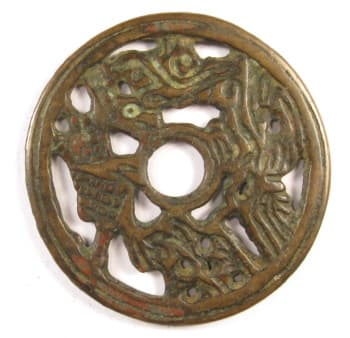
This very beautiful open work charm shows a "Chinese unicorn" or qilin (麒麟) on the left and a phoenix (?) on the right.
The qilin is a mythical animal. "Chinese unicorn" is really a misnomer because the qilin has two horns not one.
In this particular example, the qilin's two front legs are touching the outside rim at the 9-10 o'clock position with the rear legs shown together and touching the rim at the 7 o'clock position. The head is looking back with the mouth touching the central round hole. The eye happens to be highlighted with patina and the two horns can be seen at about the 11 o'clock position touching the outside rim.
Other typical characteristics of the qilin can also be observed such as the dragon-shaped head and the scaled deer-like body. The qilin can be differentiated from the deer because the qilin has a large bushy tail as can be seen here.
The "Chinese unicorn" or qilin represents good luck, prosperity, goodwill and benevolence.
The diameter of the charm is 53 mm and the weight is 25.5 grams.
Bat Open Work Charm
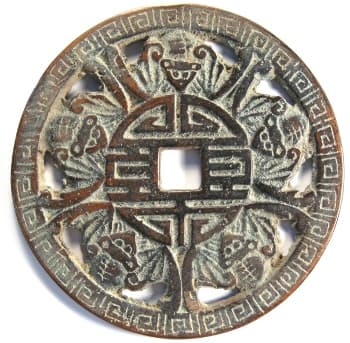 A bat
(fu 蝠) is a visual pun or rebus
for "good fortune" or happiness (fu 福) because both characters share the same
pronunciation fu.
A bat
(fu 蝠) is a visual pun or rebus
for "good fortune" or happiness (fu 福) because both characters share the same
pronunciation fu.At the left is an old Chinese charm displaying five bats.
At the very center of the charm is a large and very stylized Chinese character (壽) pronounced shou which means "longevity".
This particular design of having five bats surrounding the Chinese character shou (壽) became quite popular during the Ming and Qing Dynasties and is universally recognized by all Chinese as wu fu peng shou (五 福捧寿) or "five fortunes surround longevity".
The "five bats" symbolize the "Five Blessings", also known as the "Five Happinesses" or "Five Good Fortunes". The "five blessings" are longevity (寿), wealth (富), health and composure (康宁), virtue (修好德), and the desire to die a natural death in old age (考 终命).
This large charm has a diameter of 71 mm.
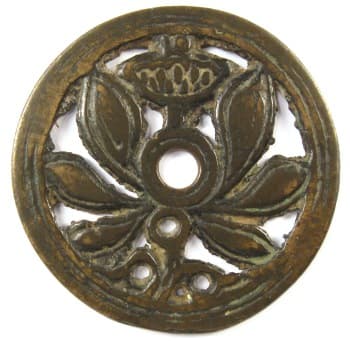
This is a very nice example of an old lotus open work charm.
In Buddhism, the lotus represents purity and detachment from worldly cares because of the dignified manner in which it emerges from the muck of a pond.
In Chinese, lotus is lianhua (莲花) or hehua (荷花). Lian is also the pronunciation for "continuous" (连) and he is also the pronunciation for "harmony" (和). The lotus, therefore, has the hidden meaning of "continuous harmony".
The top of the charm depicts a lotus pod with seeds. Lotus seeds (lianzi 莲 籽) have the hidden meaning of "continuous birth of children" because, as mentioned above, lian sounds like "continuous" and the zi has the same pronunciation as "son" or "child" (zi 子).
The charm measures 60 mm in diameter.
Flower and Vine Open Work Charms
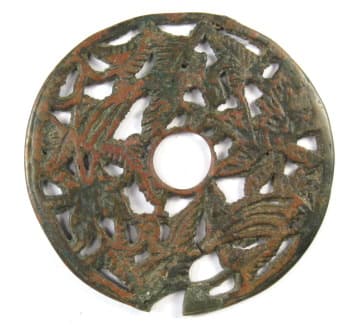
This is an example of an open work charm showing climbing vines.
It is clearly old with a very nice patina and is thinner and more delicate than my other open work charms. A small piece is missing at the very bottom.
The charm has a diameter of 53 mm and weighs 19 grams.
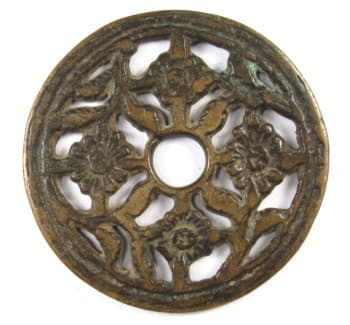
This is an example of an open work charm displaying four flowers. The flower is the tree peony or mudan (牡丹) in Chinese.
The peony has a long and fabled history in China.
One legend describes how Wu Zetian, the only Empress (690 -705 AD) of the Tang Dynasty, was drinking one day during the winter in the Imperial Flower Garden. While admiring the snow, she was also captivated by the fragrance of the winter flowers that were in bloom. She wrote a poem and sent it to the god in charge of flowers. The poem said that she would visit the garden again the next day and that all the flowers were to bloom and not wait until spring. The next morning hundreds of flowers were in bloom. But, the peony stubbornly disobeyed the order and refused to bloom. The Empress was enraged and gave orders that all the peonies in the capital city of Chang'an were to be banished. Those tree peonies that refused were burned to the ground.
From that time on, the peony gained a reputation for resistance and rebellion.
As time passed, however, the peony's reputation softened and gradually changed to one symbolizing longevity, loyalty, happiness and eternal beauty. Also, because of the way the flowers sometimes grow as doubles, they appear to the Chinese as strings of coins and, therefore, have also come to symbolize prosperity and wealth.
The diameter of this charm is 52 mm and the weight is 30 grams.
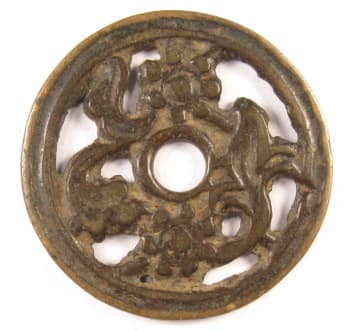
This is another charm from my collection displaying two mudan flowers.
The diameter is 47 mm and the weight is 27.6 grams.
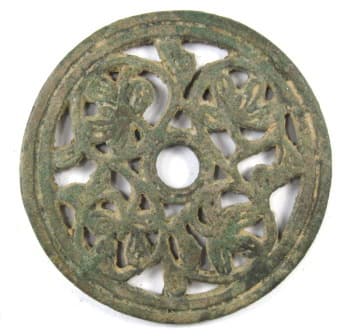
This is a variation of a four flower open work charm.
The diameter is 60 mm.
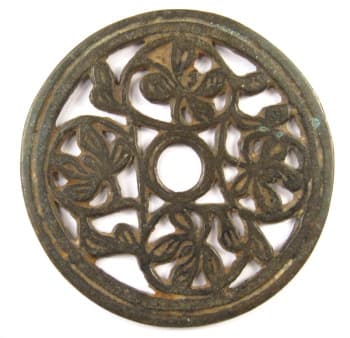
This is another example of a flower or vine open-work charm.
The diameter is 59 mm and the weight is 32.8 grams.
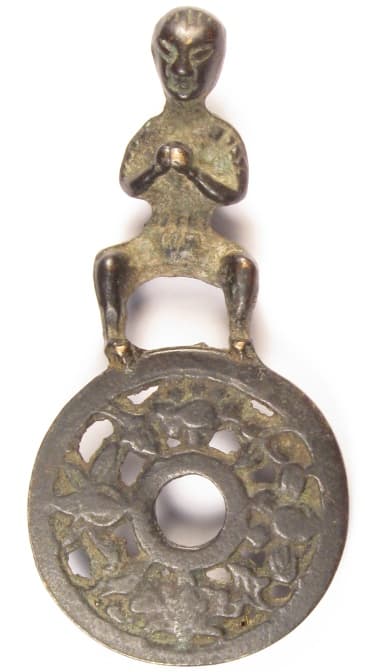
The flower open work charm at the left is unusual because it depicts a boy standing on the top.
The lower portion of the charm displays images of the mudan, plum, lotus and chrysanthemum.
For a very detailed discussion of this charm please visit Chinese Boy Charms.
Return to Ancient Chinese Charms and Coins